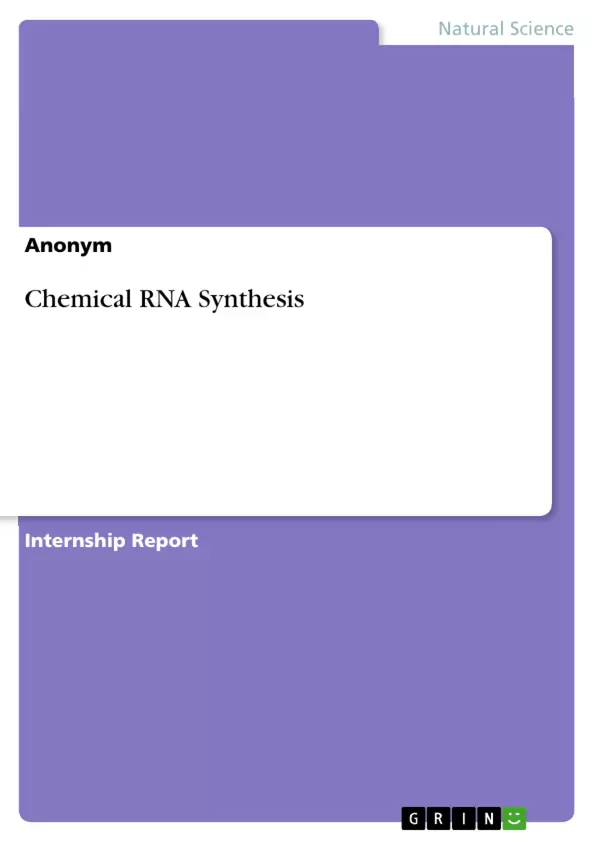Oligonucleotides that are used in various experiments such as PCR, Next Generation Sequencing or quantitative PCR can be synthesized chemically. In contrast to the natural 5’→3’ synthesis, the chemical synthesis generates the strand in a 3’→5’ direction. The first base is coupled covalently to Controlled Pore Glass (CPG). The cyclic elongation reaction consists of five steps: detritylation, tetrazolactivation, coupling, capping and oxidation (figure 1). The synthesis is automated by a synthesizing machine.
Here, we exemplarily synthesized an RNA 20mer with and without a 5’-dimethoxytrityl protection group, respectively, in a 0.2 μmol synthesis scale.
Inhaltsverzeichnis (Table of Contents)
- Introduction
- Material and methods
- Preparations and synthesis
- Cleavage from CPG and deprotection of the base
- RP-HPLC
- DMT cleavage
- Gel analysis
- Results
- Synthesis
- RP-HPLC
- Gel analysis
- Discussion
- Synthesis
- RP-HPLC
- DMT cleavage
- Gel analysis
Zielsetzung und Themenschwerpunkte (Objectives and Key Themes)
The primary objective of this work is to demonstrate the chemical synthesis of a 20mer RNA oligonucleotide, with and without a 5' protecting group, on a 0.2 µmol scale. The process and results of this synthesis are analyzed and discussed.
- Chemical oligonucleotide synthesis methodology
- Impact of 5' protecting group on oligonucleotide synthesis
- Analysis of oligonucleotide purity and integrity using RP-HPLC
- Evaluation of the effectiveness of different synthesis steps
- Importance of repetitive yields in achieving a sufficient oligonucleotide yield
Zusammenfassung der Kapitel (Chapter Summaries)
The introduction provides a brief overview of chemical oligonucleotide synthesis, emphasizing the difference between natural and synthetic synthesis directions. It highlights the five steps involved in cyclic elongation and the automation of the synthesis process. The chapter also introduces the specific oligonucleotide 20mer to be synthesized, as well as the two variations with and without a 5'-dimethoxytrityl protecting group.
The "Material and methods" section outlines the procedures used in the synthesis, including the preparation of the synthesizing machine, the solutions used, and the sequence of the oligonucleotide. It further describes the steps involved in the cleavage from CPG, base deprotection, RP-HPLC analysis, DMT cleavage, and gel analysis.
The "Results" section presents the findings from the synthesis process, including data from RP-HPLC analysis and gel analysis. This section likely discusses the purity and integrity of the synthesized oligonucleotides and may include information on the effectiveness of the synthesis steps.
The "Discussion" section provides an interpretation of the results, analyzing the efficiency of the synthesis process and highlighting the importance of factors like repetitive yields. It likely addresses the impact of the 5' protecting group on the synthesis and purification of the oligonucleotide. The discussion may also provide insights into the potential applications of the synthesized oligonucleotides in various experiments.
Schlüsselwörter (Keywords)
The key terms and concepts explored in this work include chemical oligonucleotide synthesis, 5' protecting group, RP-HPLC analysis, repetitive yields, controlled pore glass (CPG), and oligonucleotide purity. This research contributes to the understanding of efficient oligonucleotide synthesis and its applications in fields like PCR, Next Generation Sequencing, and quantitative PCR.
- Quote paper
- Anonym (Author), 2014, Chemical RNA Synthesis, Munich, GRIN Verlag, https://www.hausarbeiten.de/document/282479


